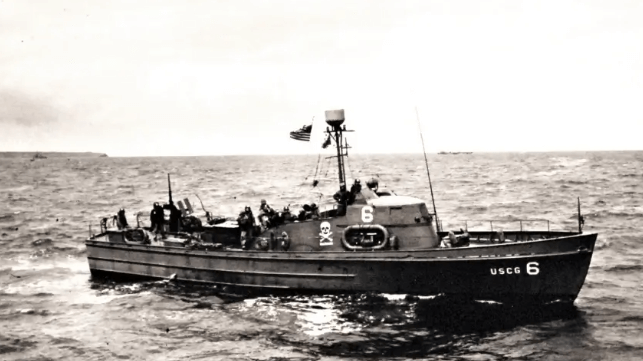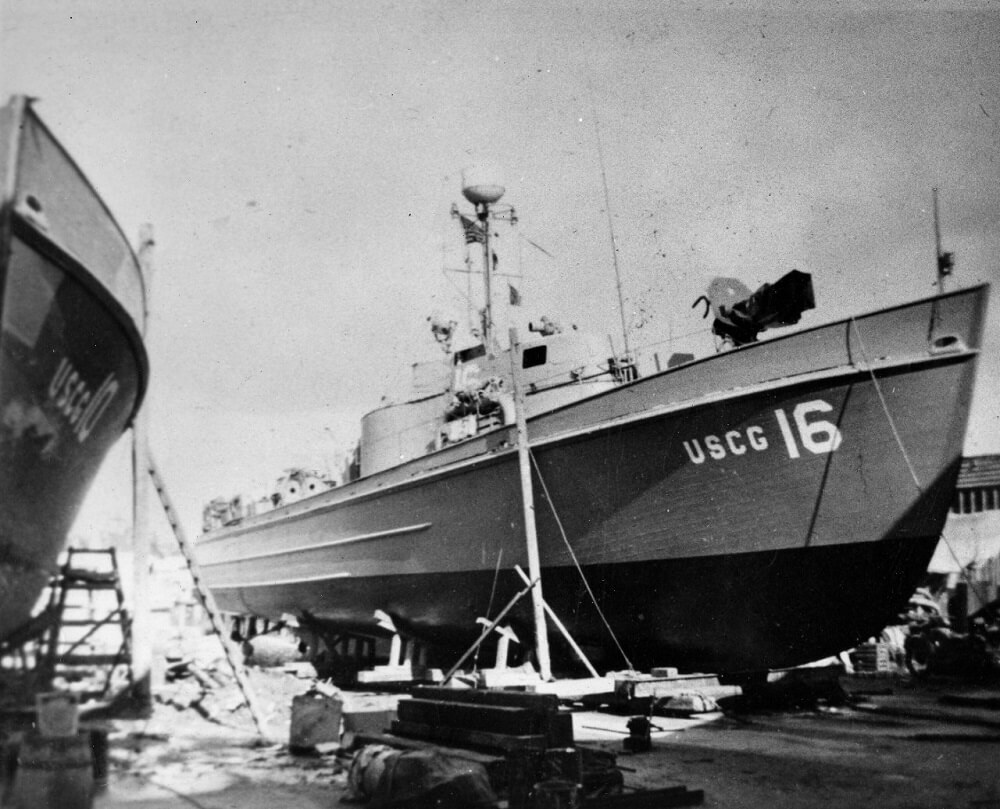Remembering D-Day: CG-16 and the Matchbox Fleet

[By PO1 Corinne L. Zilnicki, U.S. Coast Guard Historian’s Office]
The night of the invasion was unbelievable. There was a continuous flash of light in the sky and we could hear the bombs. It was nonstop fire.
- Motor Machinist’s Mate Second Class Mike Swierc
Nearly 80 years have passed since Motor Machinist’s Mate Second Class Michael J. Swierc served on the Coast Guard Cutter CG-16 off Utah Beach during the first wave of the D-Day invasion. But for Swierc, a 100-year-old Coast Guard veteran, the memory of that day of days has never faded from his mind.
Facing off against German heavy artillery, including deadly 88-millimeter batteries and numerous machine-gun nests, was not exactly what Swierc had expected upon enlisting in the Coast Guard. He and his younger brother had joined the service in 1942 hoping to protect domestic waterways and scour U.S. coastlines for enemy submarines. Instead, the farmer’s son found himself weaving through the frigid waters of the English Channel more than 5,000 miles from his hometown of Falls City, Texas.
Already a seasoned mechanic, Swierc spent the first 22 months of his Coast Guard service swept up in a whirlwind of basic training and diesel engine training before deploying overseas. The 31-day journey from Bayonne, N.J., to Ireland was fraught with difficulty. Swierc passed the days aboard his transport ship peeling potatoes, scrubbing dishes and wincing at the sound of the wind lashing against the bulkhead. “Somehow, I never got seasick,” Swierc marveled. “But we faced the most terrible storm when we crossed the Atlantic.”
The 500 destroyers, escort ships, battleships, and aircraft carriers in Swierc’s convoy kept their bows pointed doggedly into the fierce wind and arrived overseas on schedule. Upon reaching Ireland, the Coast Guardsmen joined U.S. Navy sailors in joint training sessions, honing their skills in smallboat handling, ship-to-shore movement, beach landings and general maintenance. As D-Day loomed closer, Coast Guard, Navy, and Royal navy personnel prepared their ships for the channel crossing.
Swierc’s cutter, the 83-foot CG-16, nicknamed “the Homing Pigeon,” or simply “the 16,” was assigned to Rescue Flotilla One. Also known as the “Matchbox Fleet” due to its wooden cutters, Flotilla One was a fleet of 60 Coast Guard patrol boats that had been hastily summoned a few weeks prior. Although these wooden cutters were designed to hunt submarines, their Coast Guard crews were charged with the D-Day mission of rescuing Allied soldiers and sailors during the invasion.

CG-16 at Poole, England in 1944 (Image courtesy USCG)
In the evening before June 6, 1944, ships of all kinds departed seaports along the coasts of England. At around 0400 on June 6, the Allied vessels arrived at a central rendezvous point and the combined armada headed for the coast of France. Heavy seas battered the 83-foot cutters and soaked the men, many of whom were desperately seasick. Bullets and shellfire roared to life overhead and pummeled the water all around the Allied vessels as they approached the Normandy beaches. “We didn’t really have time to be scared,” explained Swierc. “We got in there and got after it.”
As soon as CG-16 arrived off Utah Beach, Swierc and his crew dove into action. At approximately 7:30 a.m., a landing craft received a hit from a shell about 800 yards off the beach and quickly sank. CG-16 went to the rescue immediately.
As the 16 picked up the last survivor of the landing craft, another rescue began. The control ship for Utah Beach, USS PC-1261, was obliterated when an artillery shell slammed into its starboard side, instantly killing nearly half the crew. PC-1261 had led the first wave of landing craft to shore and was the first Allied ship sunk on D-Day. With shellfire peppering the water around CG-16 and the explosions of nearby mines rattling the decks beneath their feet, the Coast Guard crew began plucking survivors from the oil-slicked waves.

An 83 of the Matchbox Fleet under German fire (USN)
Upon spotting two injured Allied soldiers in the water, Swierc leapt off the cutter, swam 40 yards through enemy gunfire and fastened a rescue line around the men. “The one guy said, ‘Don’t worry about me, just get my buddy,’” recalled Swierc. “But I looked at his buddy, and he was bleeding with his head in the water. He had already passed away.”
Unflinchingly, CG-16’s head mechanic swam back through the 54-degree water while his shipmates aboard the cutter reeled in the two soldiers. This was one of many daring plunges Swierc made into the water that day. “We were out there swimming our hearts out,” said Swierc. “That water was icy cold but you just didn’t pay attention to it—you just swam.”
With 90 rescued soldiers and sailors crowding the decks, the 16 powered away from PC-1261’s floating debris field and delivered the survivors to the Coast Guard-manned USS Joseph T. Dickman, a nearby transport-turned-hospital ship.
Doctors boarded the 16 from the Dickman to help with the stretcher cases. They pronounced one man dead and declared another beyond possibility of recovery stating he would live only a few minutes. He had received a severe wound in the abdomen and the shell had carried away the side of his middle region. Due to the urgency of the work at hand, both the dead man and the dying man were taken below for later disposition. At the first opportunity, a sea burial was held for the deceased.
During the burial ceremony, the man given up for dead stuck his head through the hatch and informed the ship’s company, “If you guys think you are going to do that to me, you’ve got another guess coming. How about some hot coffee, but hot; and for sake, gimme a cigarette!” A half-hour later, chalk white but still alive and full of grit, this man was put aboard an LST hospital ship. Whether he survived or not is unknown. When last seen, he was still the man who refused to die in spite of “doctor’s orders.”
Immediately after handing over the last survivor, CG-16’s skipper, Coast Guard Lt. j.g. Richard McPhail, maneuvered the cutter back into the line of fire to recover more wounded men. An LCT was sighted about 1,500 yards from the beach under heavy fire and sinking by the stern. The vessel had struck a mine and was listing on its side, threatening to trap more than 30 crewmembers underwater. The rescue cutter maneuvered alongside only to discover the vessel was loaded with ammunition and burning.
The 16 rescued the crew and pulled away from the stricken vessel. Meanwhile, one of the survivors told McPhail that a shipmate with broken legs was still aboard the landing craft in one of the gun tubs. Despite the likelihood of an explosion from the fire raging around the craft’s cargo, McPhail put about and pulled alongside. Volunteers went aboard to get the wounded man. He was located in the gun tub and lines were slung under his arms. Suddenly, the LCT turned turtle nearly crushing CG-16. Both the volunteers and the injured sailor were thrown into the water, but Swierc and his shipmates hoisted them aboard seconds before the landing craft sank. The landing craft’s survivors were taken to an LST hospital ship for medical attention.
An 83 of the Matchbox Fleet unloading survivors to a hospital ship (USCG)
After dropping the LCT survivors, CG-16’s crew rushed to rescue survivors from a third landing craft decimated by enemy artillery shells and wallowing less than a mile offshore. The wooden 16 motored through enemy magnetic mines and unceasing shellfire to reach the men. “The whole deck was completely covered with survivors, most of them traumatically injured,” Swierc said. “It was a sad situation, but we were sent there to do it, and we did it the best we knew how.”
Despite having no formal medical training, Swierc found himself administering first aid to those sprawled across the deck of his ship. Hands that had spent countless hours picking cotton and repairing tractors injected morphine into the veins of wounded men and marked each on the forehead with an “X” to record the injection. After dulling the survivors’ pain, Swierc and his shipmates secured them in baskets and transferred them to the decks of the USS Dickman.
In all, the crew of CG-16 rescued 126 men on June 6th, more than any other ship present that day. Although the normal complement of these rescue craft was one officer and 13 enlisted men, every man who could be spared from the shore base swelled the crews for D-Day operations. On that day of days, the 16 had aboard a 16-man crew.
Swierc and his shipmates received the Navy and Marine Corps Medal for heroism, the highest military award for combat rescue. Although his award citation lauds his “cool courage” and “devotion to duty,” Swierc said he was merely doing what he was supposed to do. “The name of the game was search and rescue,” Swierc said. “I think we did our fair share.” Sixteen medals arrived for the cutter, along with 16 citations making their day of combat rescues the Coast Guard’s most honored in the European theatre of operation during World War II.
The achievements of Swierc and CG-16’s crew highlighted the mission of Coast Guard Rescue Flotilla One. The flotilla saved more than 400 men on D-Day with a third of those saved by CG-16. By the end of June, the Matchbox Fleet rescued 1,438 Allied sailors and troops. Along with most of his fellow CG-16 crewmembers, Swierc volunteered to deploy to the Pacific Theatre. However, the war ended before he got the chance to make the journey. In September 1945, Mike Swierc boarded a transport ship and headed back across the Atlantic with a souvenir tucked in his bag. He kept a set of wrenches from his beloved CG-16, which, along with the most of the other Matchbox Fleet cutters, were left behind or scrapped.
This article appears courtesy of The Long Blue Line and may be found in its original form here.
The opinions expressed herein are the author's and not necessarily those of The Maritime Executive.
